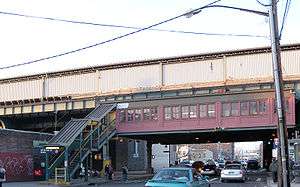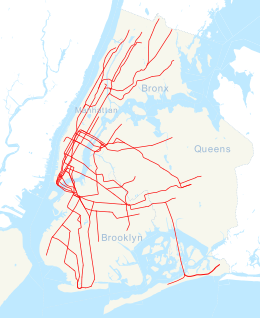69th Street station (IRT Flushing Line)
69th Street (also known as 69th Street–Fisk Avenue) is a local station on the IRT Flushing Line of the New York City Subway. Located at 69th Street and Roosevelt Avenue in the Woodside, Queens, it is served by the 7 train at all times.[3]
69 Street | |||||||
|---|---|---|---|---|---|---|---|
 South side | |||||||
| Station statistics | |||||||
| Address | 69th Street & Roosevelt Avenue Woodside, NY 11377 | ||||||
| Borough | Queens | ||||||
| Locale | Woodside | ||||||
| Coordinates | 40°44′46.53″N 73°53′48.66″W | ||||||
| Division | A (IRT) | ||||||
| Line | IRT Flushing Line | ||||||
| Services | 7 | ||||||
| Transit connections | |||||||
| Structure | Elevated | ||||||
| Platforms | 2 side platforms | ||||||
| Tracks | 3 | ||||||
| Other information | |||||||
| Opened | April 21, 1917 | ||||||
| Station code | 455[1] | ||||||
| Opposite-direction transfer available | Yes | ||||||
| Former/other names | 69th Street–Fisk Avenue | ||||||
| Traffic | |||||||
| Passengers (2019) | 1,564,387[2] | ||||||
| Rank | 286 out of 424[2] | ||||||
| Station succession | |||||||
| Next north | 74th Street–Broadway: 7 | ||||||
| Next south | 61st Street–Woodside: 7 | ||||||
| |||||||
| |||||||
| |||||||
History
The Flushing Line was opened from Queensboro Plaza to Alburtis Avenue (now 103rd Street–Corona Plaza) on April 21, 1917, with a local station at 69th Street.[4]
The platforms at 69th Street were extended in 1955–1956 to accommodate longer trains.[5]
As part of the 2015–2019 Capital Program, the MTA would renovate the 52nd, 61st, 69th, 82nd, 103rd and 111th Streets stations, a project that has been delayed for several years but is slated to begin in mid-2020. Conditions at these stations were among the worst of all stations in the subway system.[6]
Station layout
| P Platform level | ||
| Side platform | ||
| Southbound local | ← | |
| Peak-direction express | ← | |
| Northbound local | | |
| Side platform | ||
| M | Mezzanine | Fare control, station agent, MetroCard machines |
| G | Street level | Entrances/exits |
This elevated station has three tracks and two side platforms.[7] The center track is used by the peak direction express service during rush hours.[3] The extreme north (geographical east) end of the northbound platform is a closed work stair leading to a storage area below the tracks.
Both platforms have beige windscreens and brown canopies with green support frames and columns in the center and black, waist-high, steel fences at either ends. Black lampposts are at the un-canopied sections at regular intervals and the station signs are in the standard black name plate in white lettering.
The Brooklyn-Queens Expressway passes under the IRT Flushing Line just east of the station. There were formerly crossovers and switches between this station and 61st Street–Woodside. They were removed in 2008 and replaced with crossovers on either side of 74th Street–Broadway. The new crossovers are set up in such a way that trains going in either direction on the express track can stop at 74th Street.[8]
Under the elevated structure of the Flushing Line directly east of the station and the Brooklyn-Queens Expressway is a track of the New York Connecting Railroad, which is used for freight by CSX.
Exits
This station has one elevated station house beneath the center of the platforms and tracks. Two staircases from the street, one at the northeast corner of 69th Street and Roosevelt Avenue and the other at the southwest corner, go up to the mezzanine, where there is a token booth at the center and a turnstile bank at either ends. Both turnstile banks lead to a waiting area/crossunder and have one staircase going up to each platform.
References
- "Station Developers' Information". Metropolitan Transportation Authority. Retrieved June 13, 2017.
- "Facts and Figures: Annual Subway Ridership 2014–2019". Metropolitan Transportation Authority. 2020. Retrieved May 26, 2020.
- "7 Subway Timetable, Effective April 6, 2020". Metropolitan Transportation Authority. Retrieved August 18, 2020.
- "Transit Service on Corona Extension of Dual Subway System Opened to the Public". The New York Times. April 22, 1917. p. RE1. Retrieved October 2, 2011.
- Authority, New York City Transit (January 1, 1955). Minutes and Proceedings.
- "MTA To Overhaul Six Stations on the 7 Line, Currently in Design Phase". Sunnyside Post. November 19, 2019. Retrieved April 29, 2020.
- Dougherty, Peter (2006) [2002]. Tracks of the New York City Subway 2006 (3rd ed.). Dougherty. OCLC 49777633 – via Google Books.
- Dougherty, Peter (2006) [2002]. Tracks of the New York City Subway 2006 (3rd ed.). Dougherty. OCLC 49777633 – via Google Books.
External links
| Wikimedia Commons has media related to 69th Street (IRT Flushing Line). |
- nycsubway.org – IRT Flushing Line: 69th Street/Fisk Avenue
- Station Reporter — 7 Train
- The Subway Nut — 69th Street Pictures
- 69th Street entrance from Google Maps Street View
- Platforms from Google Maps Street View



%26groups%3D_bcb517497aeba8511d72a51525c8935f5e10bb26.svg)